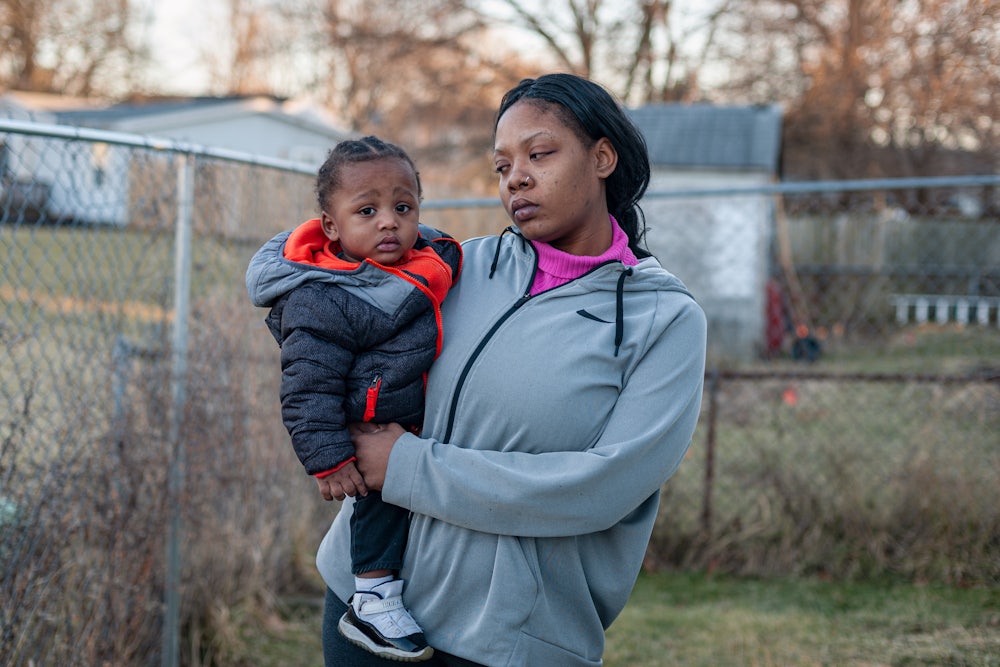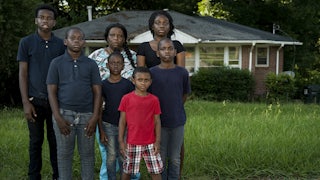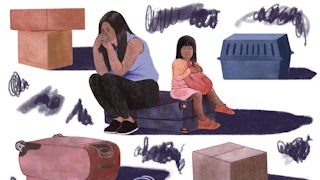By Thanksgiving, Tiesha Harris had run out of ways to cope.
She’d been living in her 2007 Chevy Trailblazer since she contracted Covid-19, fell behind on her rent, and was evicted from an apartment in September. Her four children, ages one to 13 years old, were split around Indianapolis, with three away and living in various homes, and her youngest by her side. Since their eviction, Harris had packed most of her family’s belongings into a storage unit. The rest resided in plastic bins stacked carefully in the back of her trunk.
When we spoke via a Zoom app on her phone, her face hardened into a shield of stoicism. The one moment she nearly cried—when she pointed to the winter coats she had bought at Burlington for her children—was short-lived. Then, suddenly, the soft vulnerability in her dark brown eyes disappeared, and her voice became fiercely steady. “I need to keep it together for my children,” she said.
For months, the plunging temperatures of Midwest nights had perpetually jerked her awake. Unable to bend her schedule to accommodate anything other than her $14-an-hour job as a front-desk clerk at a pawnshop and her visits to her children, she had been unable to drive to a pantry or shelter for food during the few hours they were open.
As pandemic-era protections lapsed in August 2021, a new wave of evictions spread across the country. And Harris falls into the group that has been disproportionately affected: She’s Black.
Black renters are nearly twice as likely to be evicted as their white counterparts nationwide, said Peter Hepburn, an assistant professor at Rutgers University and a research fellow at Princeton’s Eviction Lab. This uneven impact was a reality before the pandemic, and it’s persisted since Covid entered our lives.
Nationwide, the number of people forced out of their homes began gaining momentum in August, when the Supreme Court ruled that President Joe Biden’s extension of the federal eviction moratorium was outside the Centers for Disease Control and Prevention’s powers. Across the six states and 31 cities tracked by the Eviction Lab, there was a 20 percent jump in eviction filings in the three months after the court’s decision, as compared to the final three months that it was in place.
Among the large cities for which the Eviction Lab has data, Indianapolis had the fourteenth-highest eviction rate prior to the pandemic, making it “normal” in terms of U.S. evictions. In Marion County, 64 percent of the Black population rent their homes, according to the 2019 U.S. census. Comparatively, 37 percent of the white population are renters. Nationwide in 2021, 74 percent of white families owned homes, compared with 43 percent of Black families.
Indiana is already well on its way back toward the pre-pandemic reality where one in 12 renter households faced eviction proceedings in a regular year. “Renters who are harmed are disproportionately people of color,” said Fran Quigley, a clinical professor and director of the Health and Human Rights Clinic at the Indiana University McKinney School of Law. He has noticed that “landlords who benefit from those laws are corporations and individuals who are disproportionately white.”
During its heyday early in the twentieth century, Indiana Avenue was considered the epicenter of Black culture in Indianapolis. Legendary jazz greats, the likes of Duke Ellington and Ella Fitzgerald, made regular appearances. At the same time, the Avenue was a regional center of Black entrepreneurship, including Madam C.J. Walker’s theater and hair care manufacturing company, Black newspapers, Black churches, and a host of other successful Black-owned businesses.
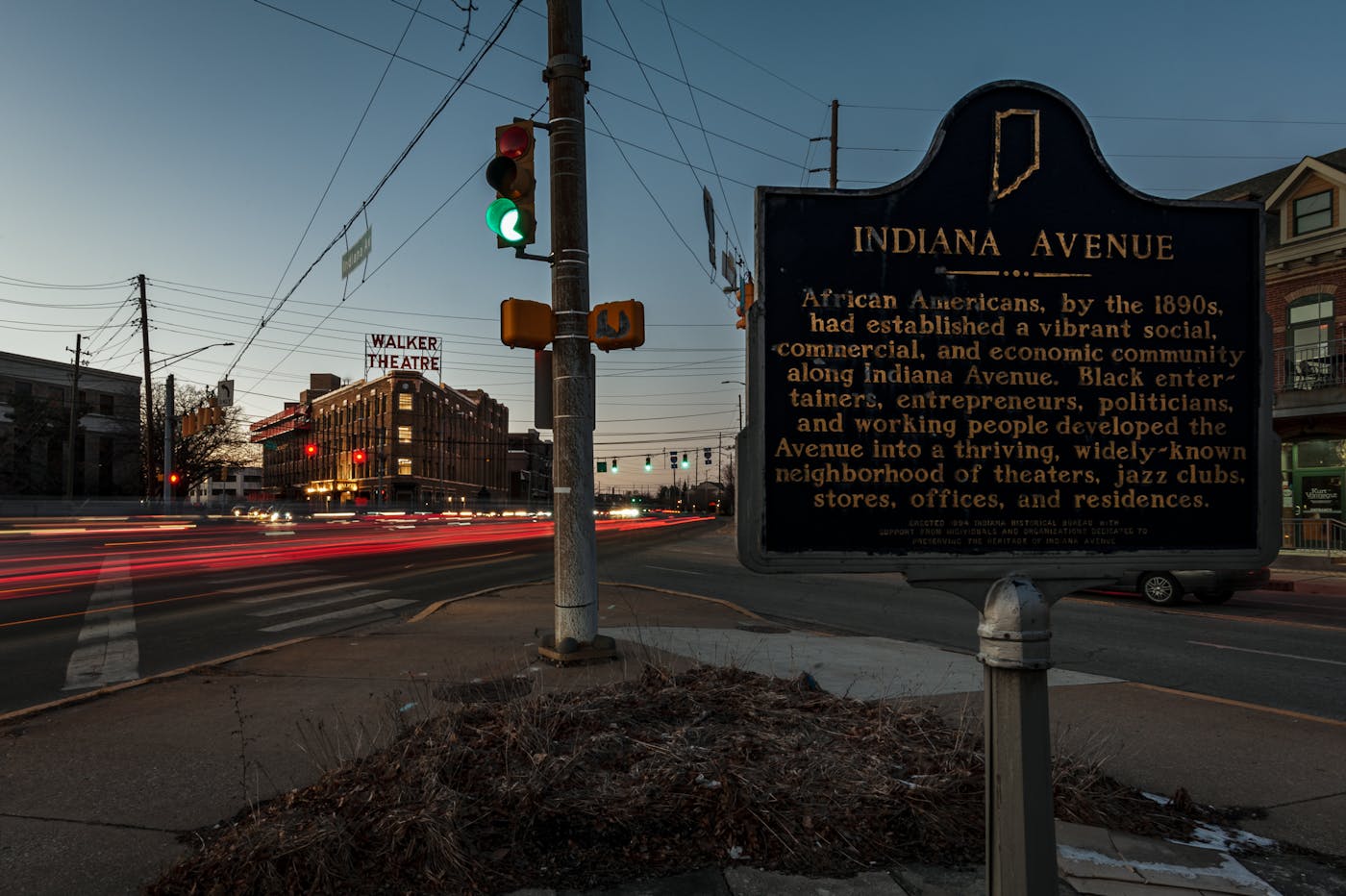
The historical nature of eviction in Indiana—or anywhere else in this country—looks the way it does in the modern era thanks to the Great Black Migration, according to Darryl Heller, director of the Civil Rights Heritage Center, established by Indiana University South Bend. Between 1916 and 1970, more than six million African Americans from the rural South relocated to the cities of the North, Midwest, and West. But in their flight from oppressive segregation laws in the South, they often ended up in the worst jobs cities had to offer—and in unhealthy, substandard housing.
Overcrowding created a housing shortage, Indiana University began expanding its campus to acres claimed uninhabitable, and the city’s chief of police publicly stated in 1939 that he intended to enforce segregation along the Avenue, where, in its prime, whites were drawn. Eventually, the common 1950s method for the extinction of Black neighborhood wealth arrived: Interstates were built, wiping out entire blocks of neighborhoods, and Indiana Avenue ceased to exist as it had been known.
Today, many Indiana residents call the east side of Indianapolis—a predominantly Black part of town—“the desert” or “the gate.” On the east side, there are no grocery stores, said Dee Ross, founder of the Ross Foundation, an organization that oversees the Indianapolis Tenants Rights Union, which fights against housing injustices throughout the city. The area is bereft of banks or transportation to get to the west side of town, where most of the well-paying jobs are. This makes being evicted from a home there even more challenging. If your car breaks down and you don’t have family to help you, you end up trapped on the east side. That’s why it’s called “the gate”—because it’s like an entrance that, for those without resources, remains locked.
Katina Roqueta, a 40-year-old customer service representative, did not have the key to unlock it. Her last of several evictions was in April 2021, she said. Soon after she moved into that apartment, she began having problems with the sewage. The toilet flooded. Around Christmas, feces started seeping into her bathtub. And she stopped paying her $926-a-month rent. Though she is making a bit over $17 an hour, she said, she hasn’t been able to pay for a decent apartment because her wages are still being garnished from a previous eviction in 2006.
When I spoke with her last fall, she was living in a home on the east side that belongs to a woman she met at church. (She’s since moved in with her new husband in Anderson, outside Indianapolis.) Roqueta is still trying to figure out what happened and why she received no notice about the garnishments, which resurfaced nearly 15 years after the eviction, she said. She did not have a lawyer.
Shaquanda McKenzie, 37, was served an eviction notice on September 22. A health care coordinator for a small company that provides in-home services, the Black single mother of three teenagers earns $16 an hour—while simultaneously studying part-time at Marion County’s Ivy Tech Community College to become a nurse.
But that steady life began unraveling last year when, after her boyfriend got into a car accident and was subsequently fired from his job at a Goodwill, he could no longer contribute toward the rent in the four-bedroom house where McKenzie had been living for two years.
At the same time, her home became uninhabitable. In July, she noticed that a wall was warping in the kitchen and there was mold growing in the cabinets. Not long after, the hosing between the washing machine and the kitchen sink stopped working, and every time she washed clothes, the kitchen sink flooded. For a while, she tried cleaning her clothes in a trash can lined with a garbage bag, and washed dishes in the bathroom tub. Then she used some of her rent money to go to the laundromat and to buy paper plates and plastic utensils. But these extra costs, along with the time and money she allocated to fixing the issues, added up, and she fell behind on rent. After she received the eviction notice, she emailed the management company to clarify whether she could simply pay the back rent and stay—or if she owed late fees. “Unfortunately,” she got in reply, “we are no longer accepting payments from you directly because of the eviction filing.”
Before her court hearing on October 21, McKenzie admitted, she was having a difficult time getting through her everyday life, let alone trying to plan next steps.
Meanwhile, her sister, who had been evicted two months earlier, was living in a hotel with her husband and daughter. Their mother, who lives in a one-bedroom house, had offered to help with money, but then changed her mind because of her own financial troubles. In November, McKenzie managed to find another home around the corner, but her old management company is suing her for maintenance issues and withholding her security deposit, forcing her to go back to court.
“I’m supposed to be the glue that holds everyone and everything together,” McKenzie said. “But all I can think is: Oh, my God, I’m going to get evicted.”
The impact of eviction can be devastating and long-lasting. An eviction on an individual’s record makes it harder for them to find safe and affordable housing in the future, forcing them to pay more for housing than they can afford and, often, to rent from an undesirable landlord.
It creates a dangerous feedback loop that, in turn, increases people’s risk for another eviction. “We are seeing so many of our clients spending 60 to 70 percent of their income on housing,” said Dee Ross.
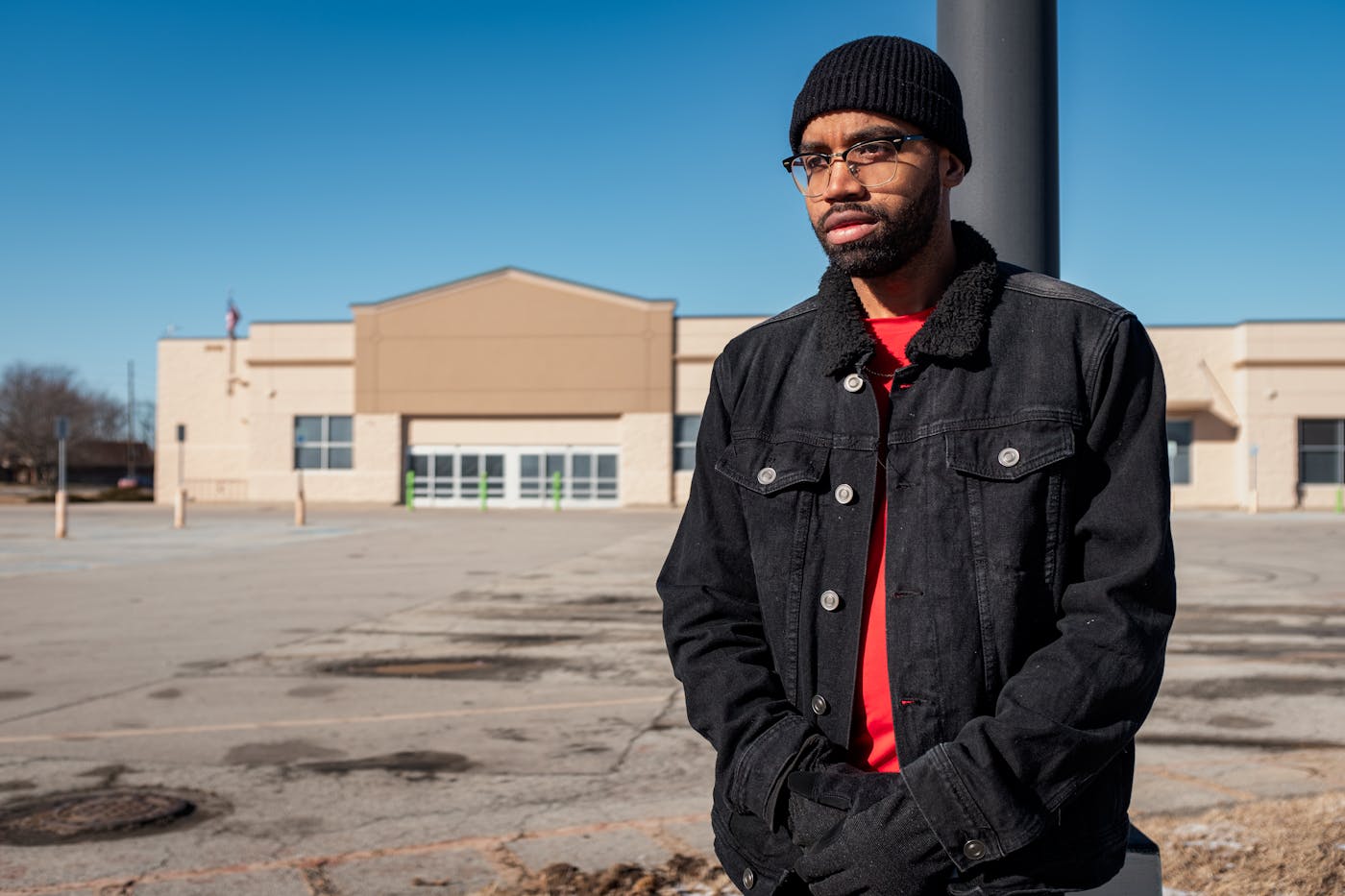
This fall, the National Housing Law Project surveyed 119 legal aid and civil rights attorneys in 41 states, D.C., and Puerto Rico about tenant welfare after the federal eviction moratorium ended in August. Forty percent of respondents reported an increase in landlords lying in court to evict tenants. To evade local tenant protections, landlords would, among other tactics, change lease terms without notifying tenants, deny receipt of funding to keep cases moving through court, or withhold maintenance to render units uninhabitable.
“It’s this power thing with landlords,” said Eric Dunn, director of litigation at the National Housing Law Project. “They’re proving that ‘I can do whatever I want with my property. Tenants shouldn’t have any rights.’”
Indiana and many other states have what legal experts call weak tenant protection laws. Entrenching the imbalance of lack of protection is the fact that, on average across the country, 90 percent of landlords have lawyers, while 90 percent of tenants don’t, according to research from 2010.
This power imbalance is why eviction is a prime indicator of systematic and institutional racism, said Elora Lee Raymond, assistant professor at the School of City and Regional Planning at the Georgia Institute of Technology. “People want to blame eviction on poverty, but I don’t want to blame poverty, because poverty is a direct result of the legacy of racism in this country,” Raymond said.
“Could there be more tenant protection laws?” Wayne Township small claims court Judge Gerald Coleman asked rhetorically when I spoke with him in December. “Certainly. [But] the only issue for the court at the time of the hearing is whether you paid your rent.”
No judge takes pleasure in evicting a tenant, he said. But a judge doesn’t have much discretion for leniency. In Indianapolis, four out of nine small claims judges handling evictions are African Americans—“me being one of them,” Coleman said. “It’s pretty clear who could do something about this problem,” he said. “The courts don’t make the laws.”
In Indiana, both the state House and Senate have Republican supermajorities. In February, the Senate voted to override Indianapolis city legislation that would have required landlords to give tenants notice of their rights and responsibilities, connected tenants to legal assistance, and restricted landlords from retaliation against tenants for exercising their rights.
In late January, I checked back in with Tiesha Harris to see how she’d been since we’d last spoken. She’d still been living in her SUV until earlier that month, but had been forced out when it stopped running. She’d briefly stayed with friends of friends, and then with the man she thought was her significant other. But he had beaten her up two days before we spoke—pulled out her hair and bruised her face.
I asked her why she didn’t stay at the homeless shelter. She said she felt people were rude, dismissed her, and made her follow rules that were unfair. For example, she couldn’t bring in outside food after a certain hour. She broke that rule by bringing in a bottle of milk for her son and got yelled at. Harris explained through her tears that less than 48 hours had passed since she had been beaten up, and there was nowhere she felt wanted, let alone safe. Throughout it all, she has managed to keep her job at the pawnshop. “That’s the only thing I have managed to keep hold of,” she said.
The GoFundMe account that she had started before Christmas has accrued an underwhelming $40. Any discretionary income she’s cobbled together she’s spent on Lyft trips to get to work, totaling $165 by late January. “I just want my voice to be heard,” she told me, “before anything really horrible happens to me.”
This piece was supported by the Economic Hardship Reporting Project.
